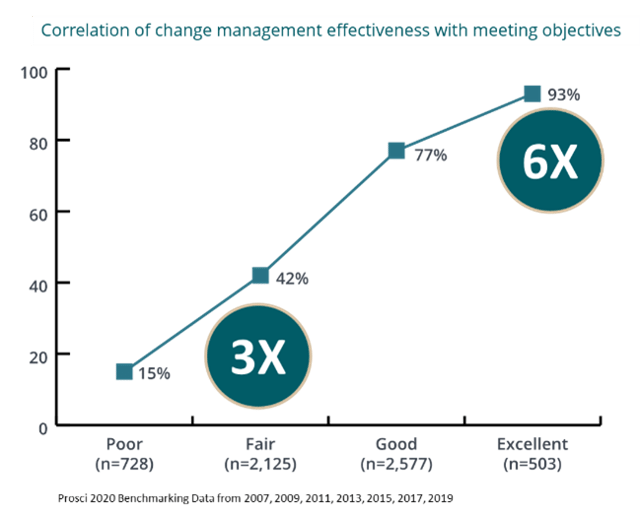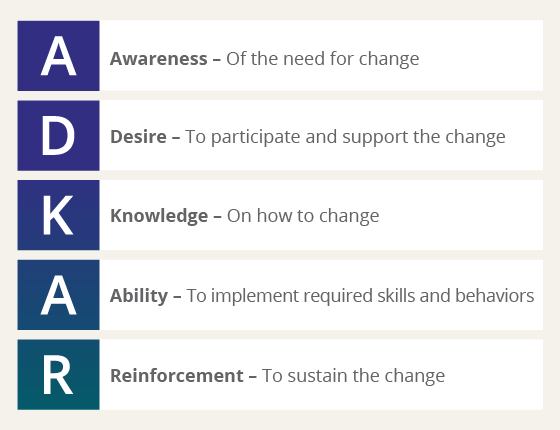Which Of The Following Steps Is Not Included In The Change Management Process?
Although it is sometimes called the soft side of change, managing the people side of a alter is oft the about challenging and critical component of an organizational transformation. Consider a merger or acquisition. The technical side of the change is certainly complex. You must piece of work out the financial arrangements of the deal, integrate business systems, make decisions about the new arrangement's construction, and more. But getting people on board and participating in the merger or acquisition can brand the difference between success and failure. Why? Individuals volition need to perform their jobs differently. The degree to which they change their behaviors and adopt new processes has a significant touch on the initiative. This is why the soft side of change tin exist the harder side of modify. Fortunately, a structured arroyo to managing the people side of change can make a big impact on overall success. Modify management addresses the people side of change. Creating a new organisation, designing new piece of work processes, and implementing new technologies may never run into their total potential if you don't bring your people along. That's because financial success depends on how thoroughly individuals in the organization embrace the change. Change management is the application of a structured process and fix of tools for leading the people side of alter to achieve a desired outcome. Ultimately, change management focuses on how to help people engage, adopt and use a modify in their 24-hour interval-to-twenty-four hours work. When defining change management, we recognize it equally both a process and a competency. The alter management procedure enables practitioners within organizations to leverage and scale the change direction activities that help impacted individuals and groups move through their transitions. The Prosci Methodology includes a robust, enquiry-based process called the Prosci 3-Phase Process: During Stage i – Ready Approach, we ask and reply: During Stage two – Manage Change, we inquire and reply: And during Phase 3 – Sustain Outcomes, we ask and answer: At the organizational level, alter management is a leadership competency for enabling change within an arrangement. It is also a strategic capability designed to increment the change capacity and responsiveness of the organization. For senior leaders, modify management competency ways beingness able to lead alter for the organization, including being an effective sponsor of change and demonstrating delivery to the modify, both individually and organizationally. For people managers working with front-line employees, competency relates to effectively coaching straight reports through their alter journeys. Although competency varies according your relationship to alter, organizations are more effective and successful when they build change direction competencies throughout their ranks. Change management is not just communication and preparation. Nor is it simply managing resistance. Effective change management follows a structured procedure and employs a holistic fix of tools to bulldoze successful private and organizational change. There are numerous reasons to employ effective modify management on both large- and minor-calibration efforts. Here are 3 main reasons: It is like shooting fish in a barrel to think almost change only from an organizational perspective. When yous consider a merger or conquering, you lot might focus on fiscal structuring, data and systems integration, and concrete location changes. Nonetheless, organizational change of whatever kind occurs one person at a time. That is because an system-wide change simply occurs when Andre, Becky, Carlos and Dharma do their jobs differently. Organizations don't change, people practise. It is the cumulative bear on of successful individual change that brings nearly successful organizational change. If individuals don't brand changes to their day-to-day work, an organizational transformation effort will non deliver results. Poorly managing or ignoring the people side of change has many consequences: Projects also endure from missed deadlines, budget overruns, rework and even abandonment. These consequences have tangible impacts on project health and the organization. Fortunately, you tin mitigate these issues when you deploy a structured approach to the people side of change. A growing trunk of data shows the touch on effective modify management has on the probability of a project meeting objectives. Prosci'due south Best Practices in Alter Management benchmarking studies revealed that 93% of participants with splendid change management met or exceeded objectives, while only 15% of those with poor change management met or exceeded objectives. In other words, projects with splendid modify direction were six times more likely to run across objectives than those with poor alter management. What may be most enlightening about the research is that poor change management correlates with better success than applying none at all. Prosci research even shows a directly correlation between effective change management and staying on schedule and on budget. Effectively managing change requires ii perspectives: an individual perspective and an organizational perspective. The individual perspective is an understanding of how people experience modify.Prosci's ADKAR Modeldescribes successful change when an individual has: The organizational perspective of alter management is the process and activities that project teams apply to support successful individual change. If the ADKAR Model describes what an individual needs to make a alter successfully, organizational modify management is the set of actions to help build Awareness, Desire, Knowledge, Ability and Reinforcement across the organisation. The Prosci Methodology is based on more than two decades of research and includes assessments and strategy to support targeted alter management plans: The change practitioner is like the managing director of the play working behind the scenes to enable actors on the phase. As a change enabler, the practitioner works to develop the modify management strategy and plans while supporting and equipping senior leaders and people managers to fulfill their unique, employee-facing roles. For instance, inquiry shows that employees prefer to receive organizational messages about change from leaders at the pinnacle of their organization. And they prefer to receive messages near the change's impact on their day-to-day work from their immediate supervisor . The practitioner's job is to enable central leaders and people managers to perform these and other employee-facing roles effectively. During t imes of change, the effectiveness of senior leaders and people managers in these critical roles will decide whether a project or initiative succeeds or fails. What can you practice to become a more effective change leader? Begin applying change management on your projects and build modify management competencies in your arrangement. These are the outset steps to ensuring projects deliver their intended results. The people side of change is not the soft side of change, it is the harder side of change. Investing the time and free energy to manage the people side of your organizational efforts pays off in the end in terms of your effort'southward success and avoiding the numerous costs that plague poorly managed change.The People Side of Change
Change Management equally a Procedure

Change Management as a Competency
Why Exercise We Need Change Management?
Organizational change happens one person at a fourth dimension
Ignoring the people side of alter is costly
Change direction increases the likelihood success

.png?width=600&name=MicrosoftTeams-image%20(13).png)
Private vs. Organizational Change Direction
Individual Change Management
 If an private gets stuck on a building block and cannot progress sequentially through the model, the change volition not be equally successful. The goal in leading the people side of alter is ensuring that individuals take Awareness, Desire, Knowledge, Ability and Reinforcement.
If an private gets stuck on a building block and cannot progress sequentially through the model, the change volition not be equally successful. The goal in leading the people side of alter is ensuring that individuals take Awareness, Desire, Knowledge, Ability and Reinforcement. Organizational Change Management
Modify Management Roles
How Y'all Can Effect Successful Change
Source: https://www.prosci.com/resources/articles/what-is-change-management-and-how-does-it-work
Posted by: liddellpacconte.blogspot.com


0 Response to "Which Of The Following Steps Is Not Included In The Change Management Process?"
Post a Comment